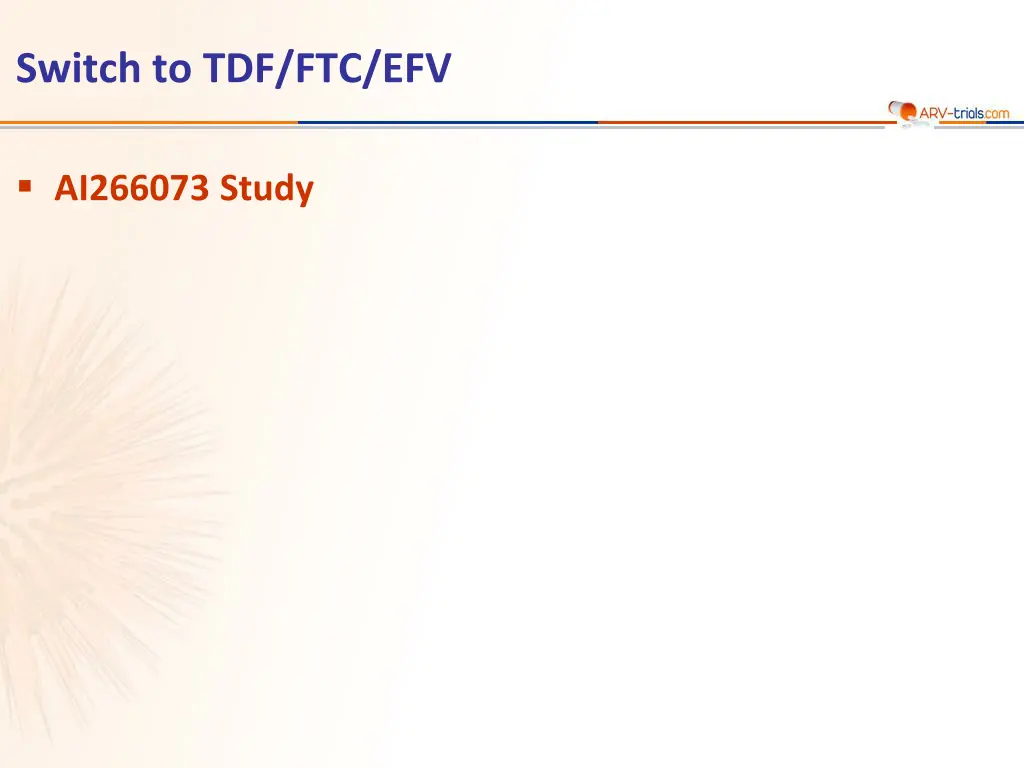
Switch to TDF/FTC/EFV Study Results
A study (AI266073) focused on switching patients with HIV from PI or NNRTI to TDF/FTC/EFV regimen showed non-inferiority in maintaining HIV-1 RNA levels below 200 c/mL at Week 48. Baseline characteristics, patient disposition, virologic response, and other key outcomes were analyzed for patients continuing stable baseline regimens. The study highlighted the efficacy of TDF/FTC/EFV in maintaining virologic response with minimal adverse events.
Download Presentation

Please find below an Image/Link to download the presentation.
The content on the website is provided AS IS for your information and personal use only. It may not be sold, licensed, or shared on other websites without obtaining consent from the author. If you encounter any issues during the download, it is possible that the publisher has removed the file from their server.
You are allowed to download the files provided on this website for personal or commercial use, subject to the condition that they are used lawfully. All files are the property of their respective owners.
The content on the website is provided AS IS for your information and personal use only. It may not be sold, licensed, or shared on other websites without obtaining consent from the author.
E N D
Presentation Transcript
Switch to TDF/FTC/EFV AI266073 Study
AI266073 Study: Switch PI or NNRTI to TDF/FTC/EFV Design Randomisation* 2 : 1 Open-label W48 Continue Stable Baseline Regimen (SBR) N = 97 306 HIV+ 18 years ARV with PI+r + 2 NRTIs or NNRTI + 2 NRTIs (exclusion of patients on TDF + FTC + EFV) No history of prior virologic failure HIV-1 RNA < 200 c/mL > 3 months Creatinine clearance 60 mL/min Switch to TDF/FTC/EFV qd fdc (single tablet) fdc = fixed drug combination N = 203 * Randomisation stratified on the use of PI or NNRTI (53% patients on PI, 47% on NNRTI) Objective Non inferiority in the proportion of patients with HIV-1 RNA < 200 c/mL at W48 (Intent-to-treat analysis, non completer = failure, TLOVR algorithm) ; lower limit of the 95% CI for the difference = -15%, 80% power DeJesus E, JAIDS 2009;51:163-74 AI266073
AI266073 Study: Switch PI or NNRTI to TDF/FTC/EFV Baseline characteristics and patient disposition Continuation of SBR N = 97 TDF/FTC/EFV N = 203 43 43 Median age, years 14% 11% Female 98% 96% HIV-1 RNA < 50 c/mL 515 517 CD4 cell count, median/mm3 3.1 2.6 Duration of current ARV regimen, median years 88% 88% Current ARV therapy as first regimen 1% 7% Hepatitis B or C coinfection Background NRTI at enrolment: TDF/ZDV/ABC 40% / 32% / 23% 37% / 42% / 23% 12 (12%) 22 (11%) Discontinuation before W48, n (%) 1 10 For adverse event 0 1 For virologic failure DeJesus E, JAIDS 2009;51:163-74 AI266073
AI266073 Study: Switch PI or NNRTI to TDF/FTC/EFV Outcome at Week 48 Virologic response (ITT, NC = F, TLOVR) for the whole population and by prior treatment stratum % 92 100 89 88 87 87 85 83 82 80 60 40 20 97 203 97 203 45 95 52 108 N= 0 HIV-1 RNA < 200 c/mL 95% CI for the difference = -6.7 ; 8.8 HIV-1 RNA < 50 c/mL Prior NNRTI HIV-1 RNA < 50 c/mL 95% CI for the difference = -5.9 ; 11.1 Prior PI 95% CI 95% CI for the difference = -3.1 ; 21.8 for the difference = -14.8 ; 8.4 SBR TDF/FTC/EFV DeJesus E, JAIDS 2009;51:163-74 AI266073
AI266073 Study: Switch PI or NNRTI to TDF/FTC/EFV Other endpoints Virologic failure SBR, N = 1 (1.03%) TDF/FTC/EFV, N = 3 (1.48%) No significant changes in CD4 cell counts within or between treatment arms Nervous System and Psychiatric Symptoms Nervous System Symptoms = SBR: 13% vs TDF/FTC/EFV: 22% Psychiatric Symptoms = SBR: 8% vs TDF/FTC/EFV: 28% Study drug discontinuation, N = 5, all in TDF/FTC/EFV group (prior PI stratum) Renal Adverse events Discontinuation for increase in creatinine, N = 1, on TDF/FTC/EFV Grade 1 treatment-emergent creatinine elevations = SBR: 3% vs TDF/FTC/EFV: 2%. No Grade 2 elevation of creatinine DeJesus E, JAIDS 2009;51:163-74 AI266073
AI266073 Study: Switch PI or NNRTI to TDF/FTC/EFV Changes in glomerular filtration rate* (mL/min/1.73 m2) 120 120 100 100 80 80 60 60 40 40 20 20 0 0 0 4 12 24 36 48 0 4 12 24 36 48 Study week Study week TDF/FTC/EFV SBR 203 97 200 95 196 95 188 92 182 89 181 87 129 58 127 57 125 57 121 54 120 51 120 50 * Evaluated by the MDRD equation TDF/FTC/EFV SBR DeJesus E, JAIDS 2009;51:163-74 AI266073
AI266073 Study: Switch PI or NNRTI to TDF/FTC/EFV Fasting lipid changes Overall, no significant differences were seen between treatment arms for fasting total cholesterol and LDL cholesterol No change in HDL cholesterol overall or in the prior NNRTI stratum Significant increase in HDL cholesterol in the TDF/FTC/EFV group vs SBR group for patients in the prior PI regimen For triglycerides, decrease of levels were significantly higher in the TDF/FTC/EFV group and was greatest in the prior PI stratum Patients questionnaires Preference of TDF/FTC/EFV over the previous regimen TDF/FTC/EFV regimen considered easier than SBR (p < 0.001) Patients in the TDF/FTC/EFV group had more symptoms of dizziness or light-headedness compared with the SBR, at W4 (p = 0.018) Improvement in diarrhoea and loose bowel movements in the TDF/FTC/EFV group for patients with prior PI-based regimen (p = 0.002) DeJesus E, JAIDS 2009;51:163-74 AI266073
AI266073 Study: Switch PI or NNRTI to TDF/FTC/EFV Conclusions Patients with stable ARV treatment and virologically suppressed on NNRTI- or PI-based therapy maintained high rates of virological suppression after simplification to a single-tablet regimen of TDF/FTC/EFV TDF/FTC/EFV was virologically non inferior to maintenance of prior suppressive ARV regimen Patients on prior PI-based therapy were more likely to experience transient nervous system and psychiatric symptoms ; for 2% of patients, these adverse events were treatment-limiting DeJesus E, JAIDS 2009;51:163-74 AI266073
